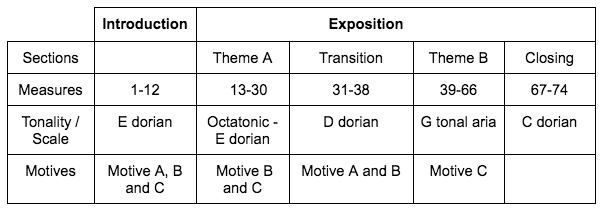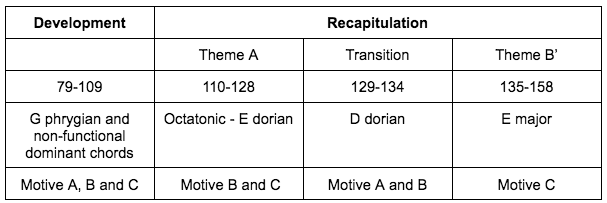Rebecca Clarke Viola Sonata
An Analysis of a Breakthrough Sonata
Introduction
In this research work I will analyze and give my opinions on Rebecca Clarke’s Viola Sonata and more specifically its first movement. I am lucky enough to be working on it at the moment and the aim of this review is to help myself and readers to get a clearer idea of the piece as well as to inspire any musician to seek out and investigate more of the notes before playing any piece.
Who is Rebecca Clarke?
Rebecca Clarke (1886-1979) was a British viola player, composer and musicologist with Post-Romantic and Impressionist influences. Clarke entered the world of music thanks to her parents who were amateur musicians. She started playing the violin when she was eight years old. In an interview in 1976 she said she told how she played chamber music with her parents. Her father played the cello and her mother the piano and also a little viola. At the age of 16, Rebecca entered the Royal Academy of Music in London, although she did not stay long since the harmony teacher asked her to marry him. Later he entered the Royal College of Music in London where he studied composition. His composition teacher recommended that he switch to the viola and so she began to study the viola with Leonel Ternis. At the beginning of the First World War he went to the United States, where he wrote his viola sonata. He died in New York in 1979. In 1919 she finished her Sonata, for viola and piano, written for the composition competition at the Berkshire Chamber Music Festival, in Pittsfield (Massachusetts).
Musical Analysis
This work is a clear example of the post-romantic sonata influenced by the German tradition. It is a sonata composed of 3 movements (Impetuous – Vivace – Adagio). On the first page of the work there is a quote, which is an excerpt from the poem “La nuit de mai” (the night of May) from the French poet Alfred de Musset. The purpose is to inspire and transmit the character and part of the inspiration that Clarke had towards his sonata.




This first movement has two very different and recognizable motifs. The first motif (motif A) is the head of the first theme and the first 4 notes of the piece. This motif is a perfect fifth jump repeated 2 times. The perfect fifth is a very stable and rough interval. Clarke repeats it twice and with the same rhythm: sixteenth note on the bottom note A and dotted quarter note on the top note E. This rhythm gives much more importance to the note above and a lot of energy to the fifth interval. The second most recognizable and important motif (motif B) is 5 notes with a very lateral movement and with a declamated and pronounced character. In addition to these there are many more motifs (for example motif C) which are presented to us in the introduction.

The mixture and variation of these 3 motifs throughout not only the first movement but the entire sonata gives this sonata a history worthy of a science fiction book. In my opinion these 3 motifs act as 3 different characters with their different characters and personalities. The play with these motifs during the different themes and with their different variations provides the sonata with a late-motive dialogue from my point of view.
One moment I want to highlight is when early in the development the viola picks up a theme from the introduction and the piano plays several of the main motifs in glamorous ways. First the A motif over a poly chord: C over Ab. But with a characteristic that is that they are fifth chords omitting the third so we only have Ab + Eb and C + G. It should also be noted that motif A is an ascending fifth jump. But 2 bars later the piano plays the C motif above the viola’s C pedalpoint. This motif C does it in quarter notes and not in eighth notes using the augmentation compositional resource but it does so with movements of parallel fifths and continuing with the polychords. This moment of the beginning of the development is sublime, in my personal experience playing this fragment after all the exposition is like entering a new world with the feeling that there are many new feelings to discover throughout the music.

Conclusion
In conclusion Rebecca Clarke was clear about what she wanted to convey with this piece and thanks to her technique both as a composer and as a violist and with the help of her husband who was a pianist the result is one of the best examples of a modern 20th century sonata with its variety of textures colors and feelings. Personally it is one of my favorite sonatas of the 20th century written for any instrument. I think that Rebecca Clarke is a songwriter and musician that not many people talk about and she deserves much more recognition than she currently has. I hope that this work encourages musicians to know, listen and play the pieces of Rebecca Clarke and other lesser known composers.
Sources
Blat, Clara María, “Rebecca Clarke: Sonata, para viola y piano. Un análisis sobre su estudio en los centros de educación superior” ,Thesis for: Master Degree, (April 2018) https://www.researchgate.net/publication/326302550_Rebecca_Clarke_Sonata_para_viola_y_piano_Un_analisis_sobre_su_estudio_en_los_centros_de_educacion_superior (accessed on 14 June 2022).
Savot, Carlynn Heather, “Rebecca Clarke’s Sonata for Viola and Piano: Analytical Perspectives from Feminist Theory” (2011). Doctoral Dissertations. AAI3492165. https://opencommons.uconn.edu/dissertations/AAI3492165 (accessed on 14 June 2022).
“Viola Sonata (Rebecca Clarke)”. From Wikipedia, the free encyclopedia. This page was last edited on 26 May 2022. https://en.wikipedia.org/wiki/Viola_Sonata_(Rebecca_Clarke) (accessed on 14 June 2022).
“Rebecca Clarke (composer)”. From Wikipedia, the free encyclopedia. This page was last edited on 13 June 2022. https://en.wikipedia.org/wiki/Rebecca_Clarke_(composer) (accessed on 14 June 2022).